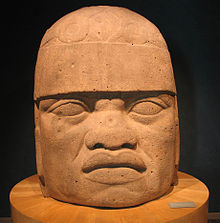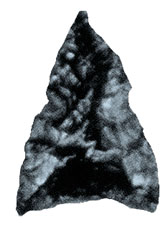User:Etejada04/sandbox/Economy of the Prehispanic Mexico
| This is not a Wikipedia article: It is an individual user's work-in-progress page, and may be incomplete and/or unreliable. For guidance on developing this draft, see Wikipedia:So you made a userspace draft. Find sources: Google (books · news · scholar · free images · WP refs) · FENS · JSTOR · TWL |
The first forms of economic organization in prehispanic Mexico were agriculture and hunting activities. The first men who inhabited the Mexican lands and part of Central America were great builders and later on creators of some of the biggest civilizations of that time, however the economy of that time was based on the commercial activities, the division of society in classes and the importance that generated in the economy the so-called Tlatoani.
Pre-classic Period
[edit]The Pre-classic period in Mesoamerica (2500 B.C. - 200 A.D.)
[edit]
During this period there was an increment in the population and sedentarism, causing the origin of complex societies with intensive cropping systems. Some researchers said that agriculture forced societies to adopt sedentary lifestyle; others think that the reason was due to the increment in the population since agriculture could supply more food than hunting.
The ancient cultures developed on that period had the tendency to manufacture and modernize ceramics. Ceramic was very important because it allowed a better transportation of materials as well as the use of ovens to create special handcrafts such as female figurines.
The early Pre-classic (2500 B.C. - 1200 B.C.)
[edit]In this period began the settlement of ancient societies, groups of small villages or small houses inhabited by large families. However, there was still not a social structure until the middle and late Preclassic period.
In agriculture, societies that settled in states such as Puebla, Tlaxcala and Tabasco started to domesticate wild plants such as corn, amaranth, pumpkin, chili pepper and green tomato. On the other hand, in the peninsula of Yucatan and Mexico, they had not yet domesticated plants.
The middle Pre-classic (1200 B.C. - 400 B.C.)
[edit]During this period, the society was divided into classes and each of them had different activities. People from the upper class or elite groups were dedicated to the organization of commerce as well as religious ceremonies, while in the lower class were mainly focused on agriculture and the construction of cities.
Long-distance trade between the ancient cultures of Mesoamerica was increasing. But above all, regional specialization was a key factor during this period. Trade was also important in order to create allegiances among their allies and vassals. However, long-distance trade was not very large since it didn’t exist any transportation for the exchange of the goods; for that reason, some cultures sent people (Tamemes) walking to those destinations. The Tamemes were in charge to carry all the products on their backs and there was a relay after every certain distance.
Civilizations of the middle Pre-classic (1200 B.C. - 400 B.C.)
[edit]Olmecs
[edit]
The Olmec is considered the mother culture of the Pre-Columbian civilizations. The Olmecs regional center was San Lorenzo (1150 - 900 B.C.) and even though their economic activity in this center is still unknown, obsidian workshops have been found. The second capital of the Olmecs was La Venta (900 – 500 B.C.) where, due to its location and easy access to natural resources, took place many important activities such as fishing, hunting and overall, agriculture.
Valley of Mexico
[edit]
Many capitals emerged in the Valley of Mexico such as Tlacopaya, Tatilco, and Coapexco; also these capitals were in charge of the trading routes. In those routes took place trade of different goods like asphalt, cinnabar, quartz, obsidian and, pyrite. Researchers have found that approximately in the year 1000 B.C. there was a great development in of hydraulic systems in semiarid regions, with the use of the chinampa, many cultures could have a better use of the land.
In the Valley of Oaxaca, there was an increment in the population and a better-structured society. The most important period of that region was San Jose Mogote, which had several adobe and stone platforms and was surrounded by many villages that produced different products like salt or were specialized in the production of handcrafts.
Trade of civilizations during the middle Pre-classic
[edit]Some examples of the most important places for trade and the product they were trading are the following:
- Cuenca de México and Guatemalan altiplano – Obsidian
- Valley of Morelos – Kaolinite
- Valley of Oaxaca –Magnetite
- Pacific Coast of Chiapas – Cocoa
- Maya civilization – Quetzal feathers
The late Pre-classic (400 B.C. - 200 A.D.)
[edit]During this period there was an increment in the construction of buildings, roads, hydraulic systems used for water storage and drainage. Also, the creation of chinampa’s and terraces allowed a better production of food which generated an increment in the population and the strengthening of centralized government. Later cities were abandoned searching for other capitals such as Teotihuacán, Cholula or Cuicuilco which were richer and had a stronger centralized government.
Cuicuilco
[edit]
Cuicuilco was the most important region in the Pre-classic, built on a very fertile land surrounded by volcanoes, among them, the Xitle volcano. It had a population of 53.000 people which was one of the most populated cities after Teotihuacán. Unfortunately, due to the eruption caused by the volcano Xitle in 100 B.C. a huge part of the population died.
Another natural disaster occurred in 1 A.D., the eruption of the volcano Popocatépetl caused the population of capital cities liked Chacaltzingo, Atlantepec, Cuajimalpa, Amaluacan, etc. to move to other capitals such as Cholula, Totimehuacan, and Teotihuacán. Thus those capitals became megalopolis which had an exponential growth in economy and culture.
Researchers affirm that the Pyramid of the Sun and Pyramid of the Moon in Teotihuacán were expected to be finished after two centuries, however, with the arrival of more people to work, the project was finished later. The main economic activity in Teotihuacán was agriculture and trade, as well as the tributes that they received from other cultures that were under their domain.
Agriculture in Teotihuacán had innovations such as the construction of terraces, chinampa and irrigation channels. Teotihuacán exported mainly cocoa, cotton, and obsidian. Near of Teotihuacán were large amounts of obsidian, a stone used to elaborate knives, arrowheads or sculptures; this allowed to trade obsidian with all the civilizations of Mesoamerica. In the Valley of Oaxaca, the great city of Monte Albán reached 14000 inhabitants (200 B.C.- 250 A.D.) and they were trading with Teotihuacán crops like corn, beans, and avocado for obsidian, jade, pottery, and salt.
Classical Period (200 - 900)
[edit]
This period is characterized by the growth of many civilizations that built large cities and improved their techniques in agriculture, goldsmithing, and ceramics. From the year 400 A.D., an increment in the efficiency of agricultural techniques achieved the transformation of the societies of that time, which besides being administrative and religious centers, served as production complexes and shopping centers. Throughout the history of the sedentary civilizations of ancient Mexico there was an important trade, especially of durable goods: specifically, raw materials and finished artifacts that were used in work processes, in war, and in rituals. Teotihuacán, the most important city of the period, had a strong influence throughout Mesoamerica, not because of its economic or military capacity, or because of its particular organization, but because of its role as producer and distributor of goods for exchange. The Maya civilization also played an important role in the Mesoamerican economy, with markets in a growing number of Mayan cities. Cities of the Altiplano had markets in permanent squares, which were attended by officials to resolve disputes, enforce standards, and collect taxes. However, the city that dominated trading was Teotihuacán, who traded with places as far away as New Mexico or Guatemala.
Other important economic activities of Teotihuacán were the handicraft production (pottery and obsidian manufacture) and the long-distance trade. In both cases, there was an important specialization and, due to the demand, it was necessary to modify techniques to produce massively (for example, through the use of molds and modeling without a lathe in the case of pottery).
Teotihuacán political and economic hegemony was based on two foreign products, over which they had a monopoly: the “orange pottery “, produced in the Valley of Puebla-Tlaxcala, and the mineral deposits in the nowadays state of Hidalgo. The existence of trade routes and redistributing centers between the great urban center of Teotihuacán and practically the rest of the Mesoamerican regions is undeniable. In Matacapán, located five kilometers east of San Andrés de Tuxtla, Veracruz, it has been postulated as a Teotihuacan enclave that operated as a redistribution of merchandise of the great city.
Post-classic Period (900 – 1521)
[edit]The early Post-classic (900 – 1168)
[edit]The changes that occurred in this period did not bring significant transformations to the great civilizations. Approximately 80% of the population of Teotihuacán left the city. New forms of colonization were established, as well as alliances between manors to consolidate certain routes and commercial flows. The war was a constant in the last centuries of Mesoamerica, generating instability in the development in a significant way.
By the year 900 Teotihuacán had been abandoned and Tula became the main urban center of the Valley of Mexico. The nearby rivers allowed to create a network of irrigation channels that facilitated feeding their inhabitants. The power of Tula was supported by the broad and strong network with other civilizations, also having cities that were under their control.
Social classes
[edit]Back then societies had no social structure, all families lived under the same conditions, the only one that stood out was the Tlatoani. There were three types of workers: landlords, land workers, and slaves. The landlords work other people's land but were not required to remain in perpetuity in those lands. The land workers dealt with patrimonial lands and lived nearby but they had to give most of the production of these lands away; also they didn’t have land of their own and were obliged to remain permanently in those lands. Slavery was not important from the economic point of view, but there were two types of slaves: the domestic ones and those that were used for sacrifice.
References
[edit]- Foias 2014, p. 14. Sharer y Traxler 2006, 659.
- Pérez Campa, 2007: 42-43.
- Plattner, Stuart, Economic Anthropology, Stanford University Press, Stanford, 1989
External links
[edit]

